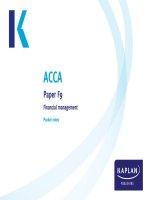ACCA paper f9 financial management FInal mock examination f9 study book
Bạn đang xem bản rút gọn của tài liệu. Xem và tải ngay bản đầy đủ của tài liệu tại đây (10.91 MB, 641 trang )
Introduction
How to Use the Materials
These Kaplan Publishing learning materials have been carefully designed to make your learning
experience as easy as possible and to give you the best chances of success in your examinations.
The product range contains a number of features to help you in the study process. They include:
(1) Detailed study guide and syllabus objectives
(2) Description of the examination
(3) Study skills and revision guidance
(4) Complete text or essential text
(5) Question practice
The sections on the study guide, the syllabus objectives, the examination and study skills should
all be read before you commence your studies. They are designed to familiarise you with the
nature and content of the examination and give you tips on how to best to approach your learning.
The complete text or essential text comprises the main learning materials and gives guidance as
to the importance of topics and where other related resources can be found. Each chapter
includes:
•
The learning objectives contained in each chapter, which have been carefully mapped to the
examining body's own syllabus learning objectives or outcomes. You should use these to
check you have a clear understanding of all the topics on which you might be assessed in the
examination.
•
The chapter diagram provides a visual reference for the content in the chapter, giving an
overview of the topics and how they link together.
•
The content for each topic area commences with a brief explanation or definition to put the
topic into context before covering the topic in detail. You should follow your studying of the
content with a review of the illustration/s. These are worked examples which will help you to
understand better how to apply the content for the topic.
•
Test your understanding sections provide an opportunity to assess your understanding of
the key topics by applying what you have learned to short questions. Answers can be found at
the back of each chapter.
•
Summary diagrams complete each chapter to show the important links between topics and
the overall content of the paper. These diagrams should be used to check that you have
covered and understood the core topics before moving on.
•
Question practice is provided at the back of each text.
Icon Explanations
Def
initi
on Key
defi
nitio
ns
that
Key
Poi
nt Ide
ntifi
es
topi
cs
that
are
key
to
suc
ces
s
and
are
ofte
n
exa
min
ed.
Exp
and
abl
e
Tex
tExp
and
abl
e
text
pro
vide
s
you
with
add
ition
al
info
rma
tion
abo
ut a
topi
c
Illu
stra
tion
Wor
ked
exa
mpl
es
hel
p
you
und
erst
and
the
cor
e
con
tent
bett
er.
Tes
t
You
r
Un
der
sta
ndi
ng Exe
rcis
es
for
you
to
co
mpl
ete
to
ens
ure
that
you
hav
e
und
Tric
ky
topi
cWh
en
revi
ewi
ng
the
se
are
as
car
e
sho
uld
be
tak
en
and
all
illus
trati
ons
and
test
you
r
und
erst
and
ing
exe
rcis
es
sho
uld
be
co
mpl
ete
d to
ens
ure
that
the
topi
c is
und
erst
On-line subscribers
Our on-line resources are designed to increase the flexibility of your learning materials and provide
you with immediate feedback on how your studies are progressing. Ask your local customer
services staff if you are not already a subscriber and wish to join.
If you are subscribed to our on-line resources you will find:
(1) On-line referenceware: reproduces your Complete or Essential Text on-line, giving you
anytime, anywhere access.
(2) On-line testing: provides you with additional on-line objective testing so you can practice what
you have learned further.
(3) On-line performance management: immediate access to youron-line testing results. Review
your performance by key topics and chart your achievement through the course relative to
your peer group.
Syllabus
Paper background
The aim of ACCA Paper F9, Financial management, is to develop the knowledge and skills
expected of a financial manager, relating to issues affecting investment, financing, and dividend
policy decisions.
Objectives of the syllabus
•
Discuss the role and purpose of the financial management function.
•
Assess and discuss the impact of the economic environment on financial management.
•
Discuss and apply working capital management techniques.
•
Carry out effective investment appraisal.
•
Identify and evaluate alternative sources of business finance.
•
Explain and calculate cost of capital and the factors which affect it.
•
Discuss and apply principles of business and asset valuations.
•
Explain and apply risk management techniques in business.
Core areas of the syllabus
•
Financial management function.
•
Financial management environment.
•
Working capital management.
•
Investment appraisal.
•
Business finance.
•
Cost of capital.
•
Business valuations.
•
Risk management.
Syllabus objectives
We have reproduced the ACCA’s syllabus below, showing where the objectives are explored within
this book. Within the chapters, we have broken down the extensive information found in the
syllabus into easily digestible and relevant sections, called Content Objectives. These correspond
to the objectives at the beginning of each chapter.
Syllabus learning objective and Chapter reference:
A FINANCIAL MANAGEMENT FUNCTION
1 The nature and purpose of financial management
(a) Explain the nature and purpose of financial management. [1] Ch. 1
(b) Explain the relationship between financial management and financial and management
accounting.[1] Ch. 1
1
The financial management function
Chapter learning objectives
Upon completion of this chapter you will be able to:
•
explain the nature of financial management
•
explain all the purposes of financial management (raising finance, allocation of financial resources,
maintaining control over resources)
•
define financial management, financial accounting and management accounting
•
distinguish between financial management and financial and management accounting and explain the
relationship between them
•
define and distinguish between corporate strategy and corporate objectives
•
define and distinguish between financial strategy and financial objectives
•
describe the relationship between corporate strategy, corporate objectives and financial objectives
•
explain the features of the financial objective of shareholder wealth maximisation
•
distinguish between shareholder wealth maximisation and satisficing in a scenario
•
explain the features of the financial objective of profit maximisation
•
explain the features of the financial objective of earnings per share (EPS) growth.
1 The nature and purpose of financial management
Key decisions for financial managers
Financial management is concerned with the efficient acquisition and deployment of both shortand long-term financial resources, to ensure the objectives of the enterprise are achieved.
Key areas of focus:
•
identifying and setting appropriate corporate financial objectives
•
achieving financial objectives, by taking decisions in three key areas:
– investment – should proposed investments (including potential acquisitions) be
undertaken?
–
finance – from what sources should funds be raised?
–
dividends – how should cash funds be allocated to shareholders?
An understanding of these three key areas is fundamental for the examination.
•
Controlling resources to ensure efficient and effective use.
In all of the above areas the financial manager will need to take account of:
•
the broader economic environment in which the business operates
•
the potential risks associated with the decision and methods of managing that risk.
The F9 syllabus covers all these key aspects of financial management.
The balance sheet (statement of financial position) and financial management
Expandable text
•
Investment appraisal considers the long-term plans of the business and identifies the
right projects to adopt to ensure financial objectives are met. The projects undertaken
will nearly always involve the purchase of non-current assets at the start of the
process.
•
For a business to be successful, as well as identifying and implementing potentially
successful projects, it must survive day to day. Working capital management is
concerned with the management of liquidity – ensuring debts are collected, inventory
levels are kept at the minimum level compatible with efficient production, cash
balances are invested appropriately and payables are paid on a timely basis.
•
All businesses need finance. A key financial management decision is the identification
of the most appropriate sources, taking into account the requirements of the company,
the likely demands of the investors and the amounts likely to be made available.
Financial management in context
Financial management should be distinguished from other important financial roles:
•
management accounting – concerned with providing information for the more day to day
functions of control and decision making
•
financial accounting – concerned with providing information about the historical results of past
plans and decisions.
Expandable text
Test your understanding 1
Management
accounting
•
Review of overtime
spending
•
Depreciation of noncurrent assets
•
Establishing dividend
policy
•
Evaluating proposed
expansion plans
•
Apportioning overheads to
cost units
•
Identifying accruals and
prepayments
Financial
management
Financial
accounting
Test your understanding 1
Solution
Show Answer
Management
accounting
Review of overtime spending
Depreciation of non-current
assets
Financial
management
Financial
accounting
√
√
Establishing dividend policy
√
Evaluating proposed expansion
plans
Apportioning overheads to cost √
units
Identifying accruals and
prepayments
√
2 The relationship between corporate strategy and corporate and financial
objectives
•
The diagram above is key to understanding how financial management fits into overall
business strategy.
•
The distinction between 'commercial' and 'financial' objectives is to emphasise that not all
objectives can be expressed in financial terms and that some objectives derive from
commercial marketplace considerations.
Objectives/targets define what the organisation is trying to achieve. Strategy considers how to go
about it.
Expandable text
•
mission
•
goals
•
objectives and targets.
•
corporate objectives
•
business objectives
•
operational objectives.
•
Corporate strategy - concerns the decisions made by senior management about the
overall purpose and scope of an organisation.
•
Business strategy – how to compete successfully in particular markets.
•
Operational strategy – how the component parts of an organisation deliver the
corporate and business level strategies effectively.
Expandable text
•
Corporate strategy concerns the decisions made by senior management about
matters such as the particular business the company is in, whether new markets
should be entered or whether to withdraw from current markets. Such decisions can
often have important financial implications. If, for example, a decision is taken to enter
a new market, an existing company in that market could be bought, or a new company
be started from scratch.
•
Business strategy concerns the decisions to be made by the separate strategic
business units within the group. Each unit will try to maximise its competitive position
within its chosen market. This may involve for example choosing whether to compete
on quality or cost.
•
Operational strategy concerns how the different functional areas within a strategic
business unit plan their operations to satisfy the corporate and business strategies
being followed. We are, of course, most interested in the decisions facing the finance
function. These day-to-day decisions include all aspects of working capital
management.
Expandable text
•
Implement a Just-In-Time (JIT) inventory system.
•
Increase EPS by 5% on prior year.
•
Acquire a rival in a share-for-share purchase.
•
Buy four new cutting machines for $250,000 each.
•
Achieve returns of 15% on new manufacturing investment.
•
Improve liquidity ratio from 1.7 to 1.85.
•
Reduce unsold inventory items by 12%.
•
Update manufacturing capacity to incorporate new technology.
•
Improve brand awareness within the UK.
Commercial objectives /
targets
Financial objectives /
targets
Strategies
Corporate level
Business level
Operational
level
Commercial objectives / Financial objectives /
targets
targets
Strategies
Corporate
level
Improve brand awareness Increase EPS by 5% on
within the UK.
prior year.
Acquire rival chain in
a share-for-share
purchase.
Business
level
Update manufacturing
capacity to incorporate
new technology.
Achieve returns of 15%
on new manufacturing
investment.
Buy four new cutting
machines for
$250,000 each.
Operational
level
Reduce unsold inventory
items by 12%.
Improve liquidity ratio
from 1.7 to 1.85.
Implement a JIT
inventory system.
3 Financial objectives
Shareholder wealth maximisation
If strategy is developed in response to the need to achieve objectives, it is obviously important to
be clear about what those objectives are.
Most companies are owned by shareholders and originally set up to make money for those
shareholders. The primary objective of most companies is thus to maximise shareholder wealth.
(This could involve increasing the share price and/or dividend payout.)
Shareholder wealth maximisation is a fundamental principle of financial management. You should
seek to understand the different aspects of the syllabus (e.g. finance, dividend policy, investment
appraisal) within this unifying theme.
Many other objectives are also suggested for companies including: profit maximisation
growthmarket sharesocial responsibilities.
•
profit maximisation
•
growth
•
market share
•
social responsibilities
Note: The objectives of other stakeholders are considered in more detail in chapter 2.
Maximising and satisficing
The objective of management has been deemed to be primarily one of maximising shareholder
wealth. However in practice a distinction must be made between maximising and satisficing:
•
maximising – seeking the best possible outcome
•
satisficing – finding a merely adequate outcome.
Expandable text
Profit maximisation
An alternative objective of profit rather than shareholder wealth maximisation was mentioned
above. There are a number of potential problems with taking this approach:
•
short-termism
•
risk
•
not cash based.
The likelihood of this objective being adopted by management is greater where managerial
performance targets (and financial rewards) are linked to profit measures such as ROCE.
Expandable text
•
Long-run versus short-run issues: In any business it is possible to boost short-term
profits at the expense of long-term profits. For example discretionary spending on
training, advertising, repairs and research and development (R&D) may be cut. This
will improve reported profits in the short-term but damage the long-term prospects of
the business. The stock exchange will normally see through such a tactic and share
prices will fall.
•
Quality (risk) of earnings: A business may increase its reported profits by taking a high
level of risk. However the risk may endanger the returns available to shareholders.
The stock exchange will then generally regard these earnings as being of a poor
quality and the more risk-averse shareholders may sell. Once again the share price
could fall.
•
Cash: Accounting profits are just a paper figure. Dividends are paid with cash.
Investors will therefore consider cash flow as well as profit.
EPS growth
A widely used measure of corporate success is EPS, and it is therefore a commonly pursued
objective.
However it is a measure of profitability, not wealth generation, and it is therefore open to the same
criticisms as profit maximisation above.
Expandable text
Chapter summary
2
Management and the achievement of
stakeholder objectives
Chapter learning objectives
Upon completion of this chapter you will be able to:
•
list all the significant stakeholders in a company and identify the likely objectives of each
•
identify and describe the main possible conflicts between the objectives of the significant stakeholders in
a company
•
identify the potential conflicts between stakeholder objectives in a scenario
•
describe the role played by management in ensuring stakeholder objectives are met
•
explain the risk of management not behaving in a goal congruent manner when pursuing stakeholder
objectives
•
describe the principle of agency theory
•
describe the range of managerial remuneration packages designed to encourage managers to achieve
stakeholder objectives
•
select appropriate remuneration packages to encourage managers in a scenario to achieve stakeholder
objectives
•
explain the guidance within the corporate codes of governance that relates to encouraging managerial
goal congruence
•
explain the terms in the stock exchange listing regulations that encourage managerial goal congruence.
1 Stakeholder objectives
Corporate stakeholders
A stakeholder group is one with a vested interest in the company.
In the previous chapter we stated that the primary objective of a company is to maximise the
wealth of shareholders. However many argue that a business must adopt the stakeholder view,
which involves balancing the competing claims of a wide range of stakeholders, and taking
account of broader economic and social responsibilities.
Typical stakeholders for an organisation would include:
•
the community at large
•
company employees
•
company managers/directors
•
equity investors (ordinary shareholders)
•
customers
•
suppliers
•
finance providers
•
the government.
Expandable text
•
The community at large – this is a particularly important group for public sector
enterprises and will have, in particular, environmental expectations from private sector
or regulated organisations, such as organic foods, safe trains and cleaner petrol. For
organisations there are problems of measurement – what are returns to the
community at large? The goals of the community will be broad but will include such
aspects as legal and social responsibilities, pollution control and employee welfare.
Recently, environmental pressure groups have achieved considerable prominence
and it is very clear that organisations cannot separate themselves from the societies
and environments in which they operate.
•
Company employees – obviously, many trade unionists would like to see their
members as the residual beneficiaries of any surplus the company creates. Certainly,
there is no measurement problem: returns = wages or salaries. However, maximising
the returns to employees does assume that risk finance can be raised purely on the
basis of satisficing, i.e. providing no more than an adequate return to shareholders.
•
Company managers/directors – such senior employees are in an ideal position to
follow their own aims at the expense of other stakeholders. Their goals will be both
long-term (defending against takeovers, sales maximisation) and short-term (profit
margins leading to increased bonuses).
•
Equity investors (ordinary shareholders) – within any economic system, the equity
investors provide the risk finance. In the UK, it is usually ordinary shareholders, or
sometimes the government. There is a very strong argument for maximising the
wealth of equity investors. In order to attract funds, the company has to compete with
risk-free investment opportunities, e.g. government securities. The attraction is the
accrual of any surplus to the equity investors. In effect, this is the risk premium which
is essential for the allocation of resources to relatively risky investments in companies.
•
Customers – satisfaction of customer needs will be achieved through the provision of
value-for-money products and services. There remains, of course, the requirement for
organisations to accurately identify precisely what those needs are.
•
Suppliers – suppliers to the organisation will have short-term goals such as prompt
payment terms alongside long-term requirements including contracts and regular
business. The importance of the needs of suppliers will depend upon both their
relative size and the number of suppliers.
•
Finance providers – providers of finance (banks, loan creditors) will primarily be
interested in the ability of the organisation to repay the finance including interest. As a
result it will be the organisation’s ability to generate cash both long- and short-term
that will be the basis of interest to these providers.
•
The government – the government will have political and financial interests in the
organisation. Politically they will wish to increase exports and decrease imports whilst
monitoring companies via the Competition Commission. Financially they require longterm profits to maximise taxation income. Equally importantly the government via its
own agencies or via the legal system will seek to ensure that organisations observe
health and safety, planning and minimum wage legislation. Also, on behalf of the
community at large, government must consider modifying the behaviour of both
individuals and organisations for environmental/health reasons, e.g. banning smoking
in certain public places and restricting the advertising of tobacco companies.
Potential conflicts of objectives
With so many different groups having a vested interest in a company it is inevitable that at times
those interests will conflict.
Conflict between and within groups of stakeholders and the need for management to balance the
various interests is a key issue.
Test your understanding 1
Suggest the potential conflicts in objectives which could arise between the following
groups of stakeholders in a company.
Stakeholders
Employees
Shareholders
Customers
Community at large
Shareholders
Finance providers
Customers
Shareholders/ managers
Government
Shareholders
Shareholders
Managers
Test your understanding 1
Potential conflict
Solution
Show Answer
Stakeholders
Potential conflict
Employees
Shareholders
Employees may resist the introduction of automated
processes which would improve efficiency but cost jobs.
Shareholders may resist wage rises demanded by
employees as uneconomical.
Customers
Community at
large
Customers may demand lower prices and greater
choice, but in order to provide them a company may
need to squeeze vulnerable suppliers or import products
at great environmental cost.
Shareholders Finance
providers
Shareholders may encourage management to pursue
risky strategies in order to maximise potential returns,
whereas finance providers prefer stable lower-risk
policies that ensure liquidity for the payment of debt
interest.
Shareholders/
managers
Customers may require higher service levels (such as 24
rather than 48 hour delivery) which are resisted by
shareholders as too expensive or by management due
to increased workload.
Government Shareholders
Government will often insist upon levels of welfare (such
as the minimum wage and health and safety practices)
which would otherwise be avoided as an unnecessary
expense.
Shareholders Managers
Shareholders are concerned with the maximisation of
their wealth. Managers may instead pursue strategies
focused on growth as these may bring the greatest
personal rewards.
Customers
Expandable text
2 The role of management and agency theory
Agency theory
Agency theory is often used to describe the relationships between the various interested parties in
a firm and can help to explain the various duties and conflicts that occur:
Agency relationships occur when one party, the principal, employs another party, the agent, to
perform a task on their behalf. In particular, directors (agents) act on behalf of shareholders
(principals).
Expandable text
Test your understanding 2
Fill in the gaps in the following table of agency relationships in a company.
Principal:
Shareholders
............................
Loan creditors
Agent:
.........................
Employees
.............................
Agent’s responsibility:
.........................
............................
............................









